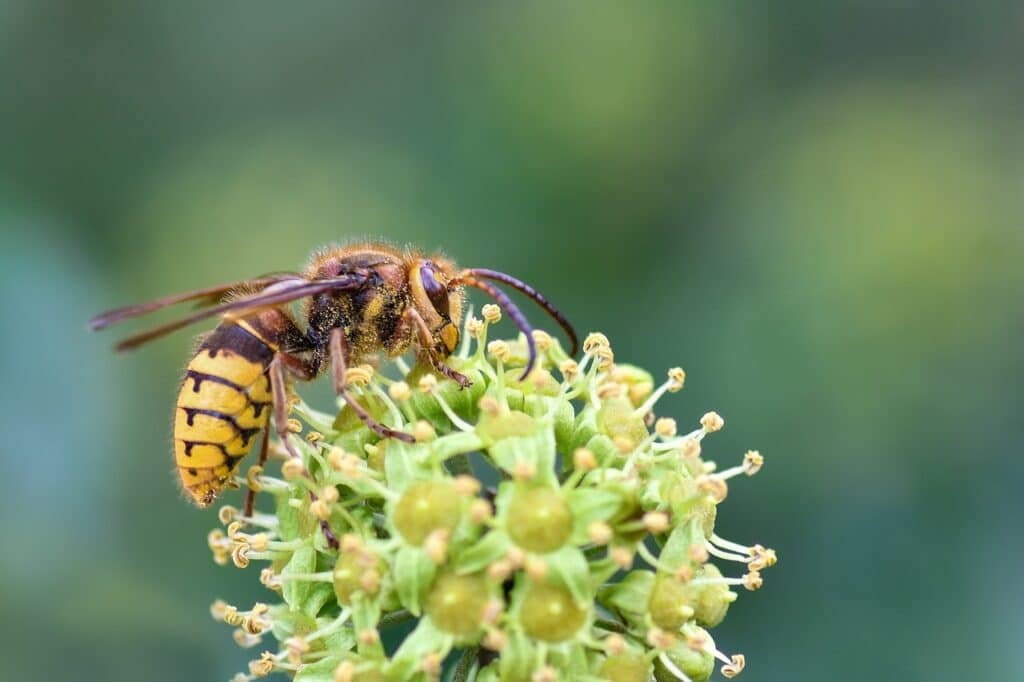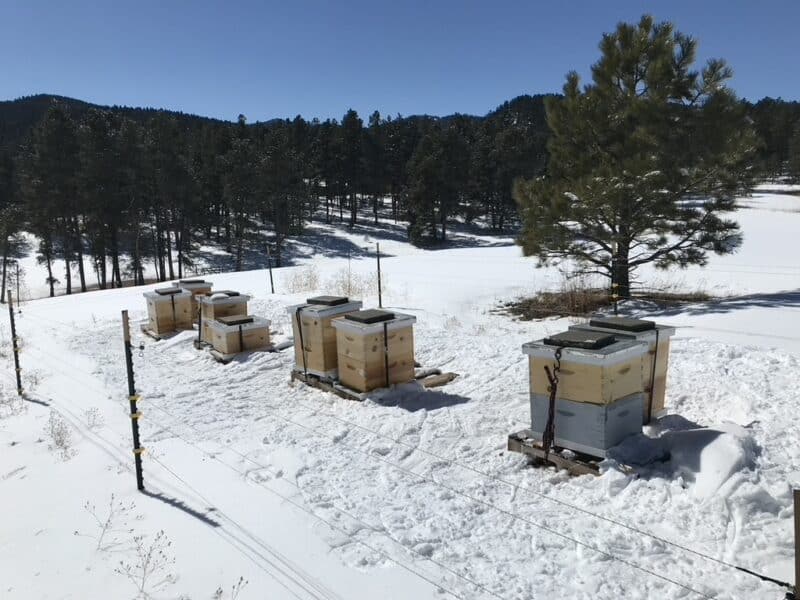Contents:
- What is a Wasp?
- Solitary vs. Social Wasps
- How to Identify a Wasp
- Are Hornets a Type of Wasp?
- Hornets vs. Wasps
- 20 Types of Wasps
- Wasp Prevention and Removal
- Our CEO Noah Wilson-Rich’s Favorite Type of Wasp
- How Noah Would Describe Wasps in Three Words
- FAQs
What is a Wasp?

A wasp is a winged pollinator found everywhere in the world, except for Antarctica. Worldwide there are more than 30,000 identified species of wasps, and each vary in color, size, and even nesting habit. Similar to the bee species, wasps receive carbohydrates from the same source, flowering plants. However, wasps are also identified as carnivores as they rely on meat for protein, whereas the honey bee follows a vegan diet and instead gets protein from pollen.
Although wasps are often feared by people because of their bright color and ability to sting more than once, wasps are considered vital (and mostly docile!) pollinators that perform essential functions that protect our ecosystem, like pollinating plants and acting as a natural pest management system. Wasps have chewing mandibles, or chewing mouth parts that come together like scissors so that they are able to consume protein from pests that are often found in gardens.
“We see wasps as cousins to bees, and we also see ants as the third and final cousin to bees and wasps. They’re all classified in the same branch of the evolutionary tree that is called Hymenoptera.”
– Noah Wilson Rich
Solitary vs. Social Wasps
Scientifically, social insects are defined as having an overlap of generations, cooperative care of the brood (babies), and reproductive division of labor (typically called queens and workers). A solitary insect is the exact opposite, in which the insects live by themselves and don’t interact with or rely on others to survive. Solitary wasps usually make their nests underground and it is uncommon to see them flying around–these types of wasps are also unlikely to be aggressive and rarely sting since they are not socialized like the honey bee. To learn more about the nesting behaviors of wasps, click here.
How to Identify a Wasp
Similar to the identification of any species, it is possible to identify different types of wasps through observation. Wasps are often mistaken for other species of bees like the honey bee – but it’s important to know the distinction between the two!
The media has widely reported the recent losses of bees, leading to a range of responses from interest and concern to outrage, but they also often report that bees sting and sometimes kill humans. Yet bees, unlike wasps, are likely to sting only if their colony is threatened or they are being squashed. As we have seen, humans are not always friendly towards bees, but we may be less likely to want to help them if we believe that they are the enemy.
Most people’s fears of “bees” are fueled by a lack of knowledge or by mistaken identity. In the United States, the yellow jacket and the paper wasp can sting repeatedly with their smooth (unbarbed) sting. These are aggressive social wasps nesting underground, in hollow trees, in crevices, or under the eaves of houses and similar structures. These wasps have a thin waist, lack pollen baskets, and are less hairy than bees, but many people still mistake them for bees.
Are Hornets a Type of Wasp?
Many people are often shocked to learn that yes, all hornets are wasps – but not all wasps are hornets! Typically, people will refer to hornets and wasps interchangeably, but it’s important to know the distinction between these two insects. According to Almanac.com, there are actually no native species of hornets in the United States, and the only true species of hornet found here is the European hornet, which was introduced into New York in 1840.
Hornets vs. Wasps
Hornets
- Size: 1 to 1.5 inches
- Nests: Nests are aerial or in a protected aerial location; large in size, globular and made from paper. From 100-700 workers.
- Color: Black & white; brownish-reddish
- Diet: Prey on other insects and rarely are scavengers for sweets and proteins
- Likelihood to Sting: Very aggressive when the nest is disturbed; many stinging individuals
Check out THE SCHMIDT INSECT STING PAIN INDEX: a ranking of the pain and duration of various insect stings, created by entomologist Dr. Justin Schmidt.
Wasps
- Size: Most wasps are smaller than hornets – 1 inch or less
- Nests: Both aerial paper nests and ground nests. While yellow jackets will build above and below ground, they build underground most often. The paper wasps have no paper envelope enclosing and protecting the nest. From 100-5000 workers
- Color: Wide variety of colorations.
- Diet: Prey on other insects and are very likely to scavenge for sweets & proteins
- Likelihood to Sting: The yellow jackets are very aggressive, but the paper wasps are not likely to sting unless threatened.
20 Types of Wasps
Yellow Jackets
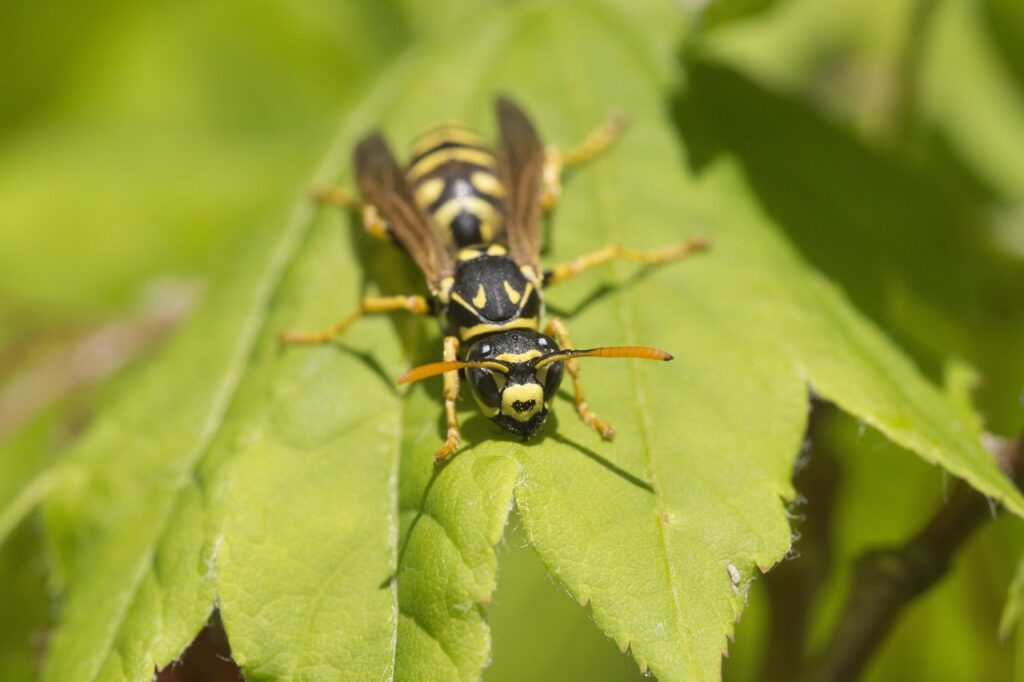
- Physical description: Black with yellow markings on the front of the head and yellow stripes wrapping around the abdomen. Large antennae and dark eyes.
- Region: Commonly found throughout the world, but especially present in the southeastern United States.
- Habitat and nests: The nest is constructed from paper-like material that is sourced by the queen, then chewed and used to create multiple layers. Can be found underground or in and around houses.
- Behavior: You’ve likely seen this wasp while you were out enjoying a picnic, as these pollinators prefer to feed on other insects, bees, but also fruit (and what they can find in your picnic basket). These are social insects that live in large colonies. Yellow jackets will sting in order to protect the nest site.
Northern Paper Wasps

- Physical description: Slender, reddish-brown body with yellow bands (although specific appearance varies by habitat.
- Region: Found throughout temperate North America, but most commonly found in the Midwest United States, according to InsectIdentification.org.
- Habitat and nests: Often found in wooded environments where materials can be used to form nests. This species also uses its mandibles and saliva to chew and create a pulp-like paste. Nests can be found attached to homes, barns, sheds, fences, etc.
- Behavior: These are very social wasps and rely on the entire colony for food, shelter, and protection. This species of wasp has even developed the ability to recognize the faces of other wasps within its colony, and can also identify wasps that do not belong. This wasp will sting to protect its nest if it feels threatened.
Mud Dauber Wasp
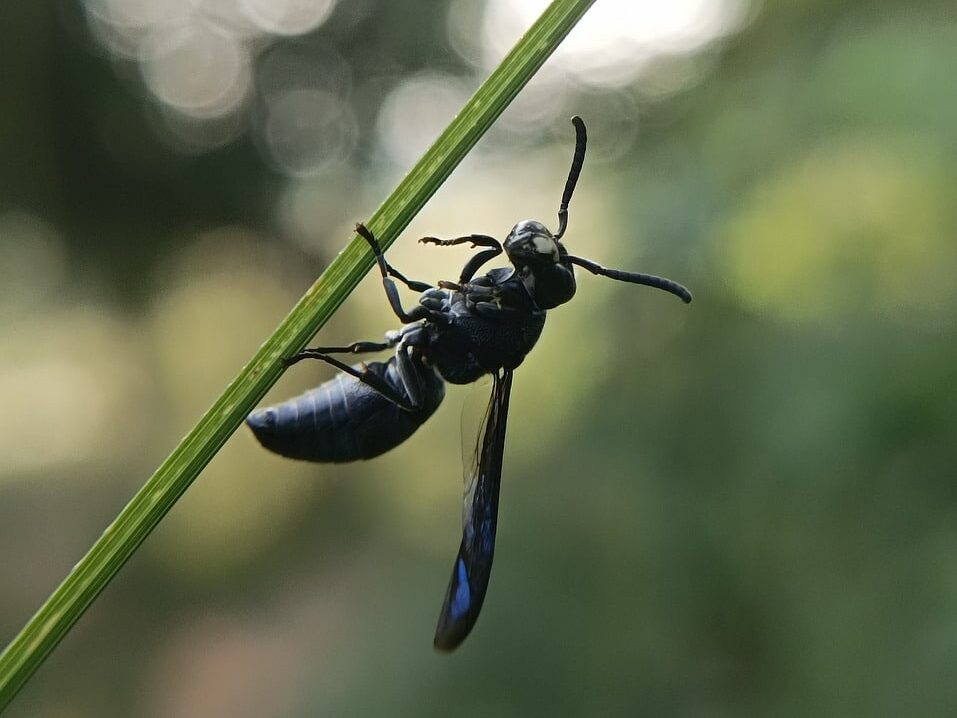
- Physical description: Usually black, with a “thread-waisted” body, and can often have blue metallic luster or other light markings. Wings are clear or dark.
- Region: Found throughout the United States.
- Habitat and nests: Also referred to as a “mud dauber”, a mud wasp constructs its nest out of mud and can often be found on the sides of buildings or bridges. A mud wasp is also a solitary wasp, which means that there is one wasp building a single nest and calling it home. These nests are constructed with mud or clay, in addition to the saliva of the insect, and these materials are formed into a tube-like structure.
- Behavior: Mud Daubers are not naturally aggressive and are unlikely to sting. These wasps are actually beneficial in controlling spiders.
Bald-faced Hornet

- Physical description: Black with white or ivory-colored markings on their faces.
- Region: Found throughout the United States, but most common in the southeastern United States.
- Habitat and nests: According to SuburbanExterminating.com, bald-faced hornet nests (which are grey and aerial) can be found at least 3 feet above the ground in bushes, shrubs, fences, lights, and under the eaves of buildings.
- Behavior: Likely to attack anything that invades its space by stinging. Bald-faced hornets feed on bees for protein, and are attracted to light according to PestCo.com.
Blue-winged Wasp

- Physical description: Metallic blue wings, black upper body, and reddish-brown abdomen that is marked with two yellow spots.
- Region: Can be seen from New England to Florida and west to the Rocky Mountains in North America.
- Habitat and nests: The blue-winged wasp is typically seen flying a few inches above the ground as they search for beetle grubs. When it comes to nesting habits, this wasp builds its nest in the ground. According to CatsEyePest.com, these nests are similar to ant colonies since they have multiple chambers that break off from the main entrance.
- Behavior: Even though they’re a larger species of wasps, these wasps are mostly harmless if they are left to fly and search the ground for grubs. Females do have a stinger and will use it if they feel threatened – the male blue-winged wasp does not have a stinger but can attack via swarming.
Thread Waisted Wasp
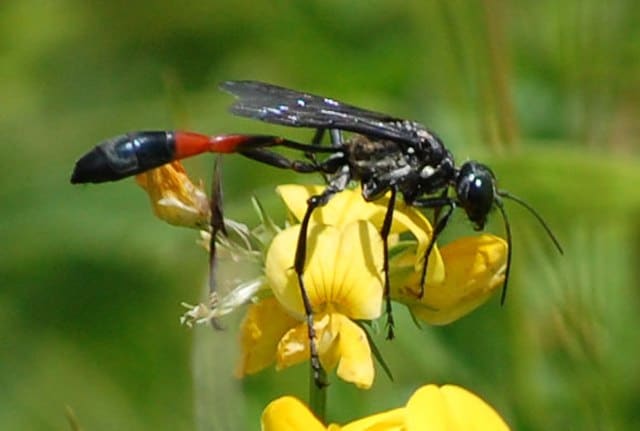
- Physical description: Long body with a “thread-waisted” look. Can be all black, black and red, yellow and black, or white and black, with markings on their abdomen.
- Region: Common species found from southern Canada to Guatemala.
- Habitat and nests: BioSurvey.Edu notes that thread-waisted wasps are generally solitary nesters that inhabit much of the world and can build ground or aerial nests out of mud. Adults also feed on nectar from flowers, honeydew, and body fluids of their prey.
- Behavior: This wasp species is known to be parasitic on insects and spiders. By crushing the neck of the host, they are able to paralyze the insect, allowing them to place the body in a mud cell and lay eggs on top of it. Once the egg hatches, the larva will eat the insect that hosted it.
Asian Giant Hornet
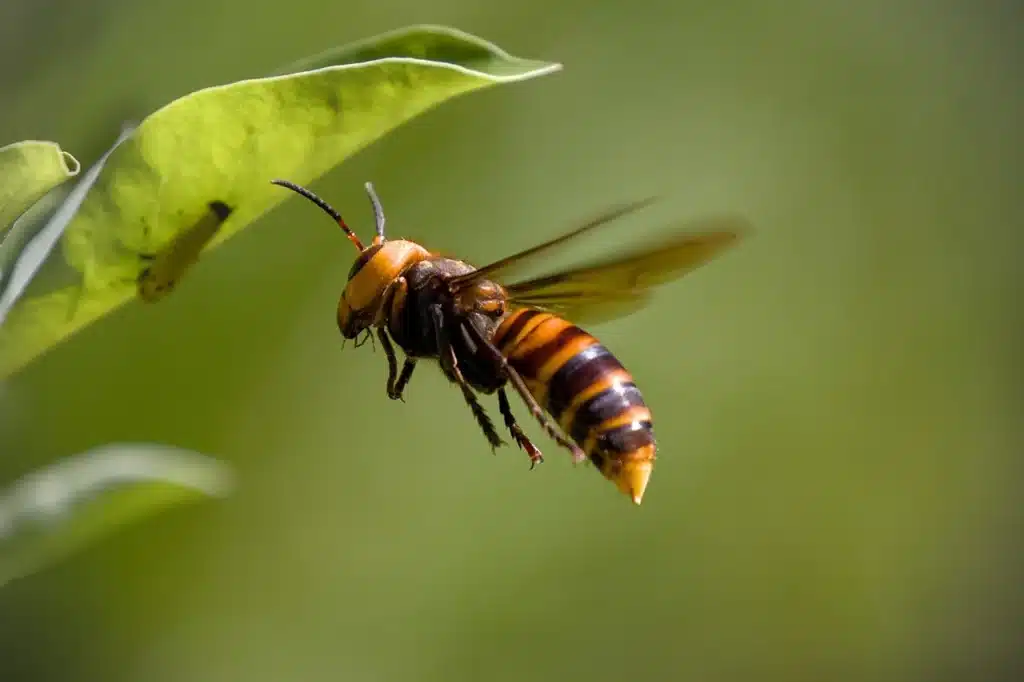
- Physical description: Known as the world’s largest hornet, measuring up to two inches in length. Has a yellow/orange head, a black thorax, and a black and yellow/orange striped abdomen.
- Region: Native to Japan, Korea, and other parts of Asia. Was first detected in the United States in 2019 in the State of Washington.
- Habitat and nests: The Asian giant hornet typically lives underground by digging holes and occupying pre-existing tunnels that were created by other animals.
- Behavior: Also known as the “murder hornet”, this insect uses mandibles against its prey, “decapitating the bees and flying away with the thoraxes to feed their young.” Its stinger is even strong enough to piece through a beekeeping suit, and the venom is said to be excruciating. Giant Hornets can even hurt our food system, impacting our nutrition and the health of our future generations.
Cow Killer Wasp
- Physical description: Up to ⅞” with antennae and six legs. Its body is black with areas of very bright red, orange, yellow, or white. Females are wingless, and males have wings.
- Region: Found throughout the United States.
- Habitat and nests: The female wasp, since they do not have wings, are usually seen on the ground in the warm summer months. Male wasps are generally found on flowers. The cow killer wasp is also mistakenly referred to as the cow killer ant or a velvet ant.
- Behavior: As you can probably tell from the name, these wasps have a very potent sting (but their sting will not actually kill a cow). In reality, these wasps are rarely aggressive.
European Paper Wasp

- Physical description: ¾” long with a slender body and threaded waist. This wasp is black with yellow markings.
- Region: Native to Europe, but first found in North America in Boston in the 1970s. It has now spread to more parts of the northern U.S. and British Columbia.
- Habitat and nests: Similar to other paper wasps, their nests are constructed from paper-like materials found on weathered fences or porch decks. The nest includes hexagonal cells where new eggs are laid and hatched.
- Behavior: The European paper wasp is an excellent example of natural insect control in gardens or yards. This wasp is often mistaken for yellow jackets or hornets, and although it is not aggressive, this wasp can sting.
German Yellow Jacket
- Physical description: Worker yellow jackets are approximately ½ “ in length, and this yellow jacket is black and yellow. Its abdomen typically has a small spade-shaped black mark and a series of black spots down both sides.
- Region: Native to Europe, but can now be found throughout most of the northeastern United States, into Canada, and down the Pacific coast. It is also found in Chile, Argentina, New Zealand, and Australia.
- Habitat and nests: Solitary queen wasps will overwinter in protected areas and will start new colonies in a structural cavity in the spring. Nests are constructed with the combination of chewed wood fibers and saliva and can host more than 4,000 wasps in July or August. This insect is known to occasionally reuse previous year’s nests.
- Behavior: German yellow jackets are very defensive of their nests and will chase other animals away (even sometimes for long distances!).
Spider Wasp
- Physical description: ½ to 2 inches in length with a black or blue body. Wings are black, blue or orange-yellow, and this insect has curled antennae.
- Region: Found in many areas all over the world, from South Africa to North America.
- Habitat and nests: Spider wasps create their nests from mud pots that were used and left behind by mud daubers. Females will drop a paralyzed spider into the pot and lay a fertilized egg with it.
- Behavior: This insect was given the name spider wasp because of its ability to hunt spiders – they do this by attacking jumping spiders and even ripping off the legs of spiders before bringing them back to their nest. Since you’re most likely to find this wasp in a garden, it’s best to leave the spider wasp alone because of its painful sting.
Cicada Killer Wasp
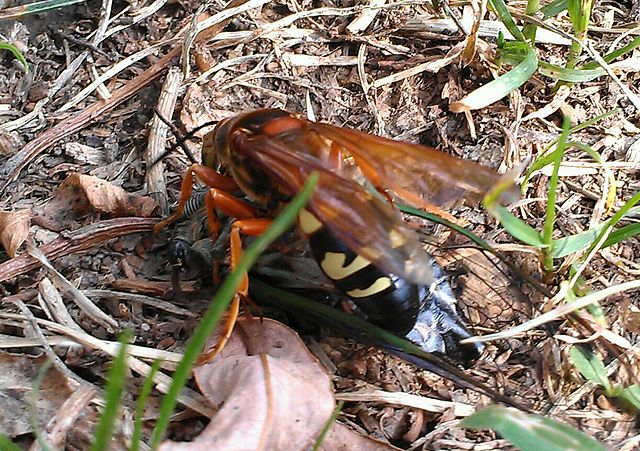
- Physical description: Adults are 2 inches in length, with black abdomens, red-orange legs, and yellow markings on their body.
- Region: Out of all the types of wasp on this list, we’re sure an American east coast reader will instantly recognize this huge wasp! It’s found in the eastern United States and in other parts of the world.
- Habitat and nests: These wasps are found in urban areas, forests, and woodlands. These solitary wasps build their nests underground, about one foot deep in loose soil.
- Behavior: Cicada-killer wasps hunt in the trees for cicadas and use their mandibles to pierce the prey. Similar to other wasps, they will sting and paralyze their prey before dragging (or flying) the body back to its nest where an egg is laid on it. These wasps are very large and can have a painful sting, although they’re unlikely to sting a human unless they feel very threatened.
Southern Yellow Jackets
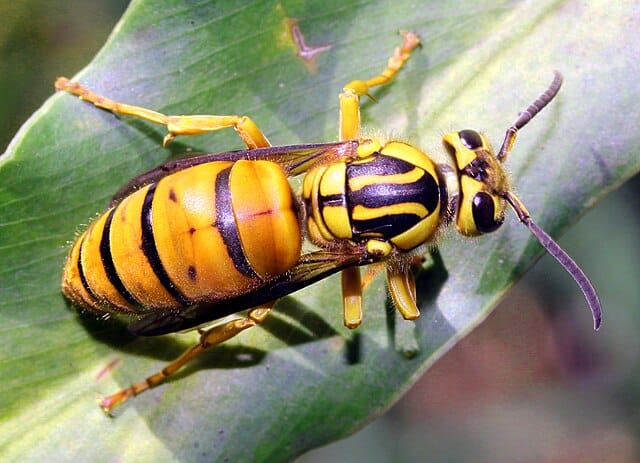
- Physical description: Workers are ½” inch in length with yellow and black stripes.
- Region: Found in Texas and eastward in the country, as well as south to Central America.
- Habitat and nests: Southern yellow jackets use their mandibles to chew into wood fiber that creates paper for their nests. These nests are often found underground but can also be seen in tree holes or wall voids. You’ve likely seen them foraging around garbage cans, picnic tables, and gardens.
- Behavior: This wasp is aggressive in nature and has a tendency to sting (even multiple times) if provoked. These incidents are usually from people unknowingly stepping on a southern yellow jacket nest since it’s found near the ground.
Braconid Wasps
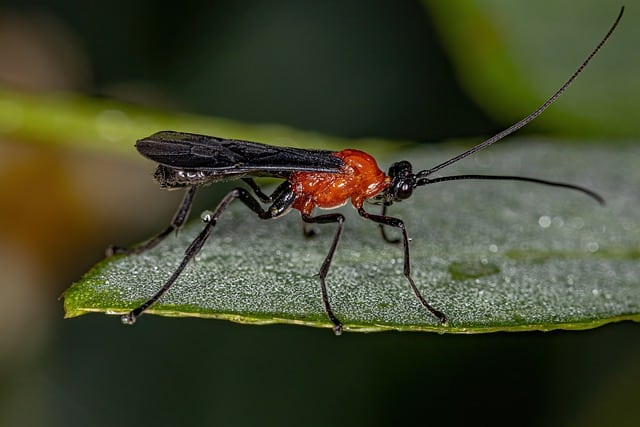
- Physical description: Less than ½ inch long with narrow waists and ant-like heads. Appears black at first, but upon closer inspection, this wasp has orange or reddish abdomens.
- Region: Found worldwide wherever moths and butterflies are common.
- Habitat and nests: Flowers with small florets like most herbs are ideal for this wasp since it is so small.
- Behavior: Braconid wasps play an important part in organic pest control, and will lay their eggs on soft-bodied caterpillars that are usually seen munching in the garden. This wasp does not sting.
Potter Wasps
- Physical description: Up to ¾ inch long and black with yellow markings on its abdomen, and thorax. Has a small narrow waist and its wings are folded in half, lengthwise, when at rest.
- Region: Found throughout the northern hemisphere, mainly in temperate regions in woodlands or urban areas.
- Habitat and nests: Potter wasps create nests that look like small pots out of mud and can be seen on twigs and branches of trees. Females will lay one egg inside each chamber, along with a paralyzed caterpillar before sealing the pot. In order to hatch the larva must dig itself out of the chamber.
- Behavior: This solitary wasp is closely related to the paper wasp, although it does not form colonies. They can deliver painful stings but rarely attack humans.
Cuckoo Wasps
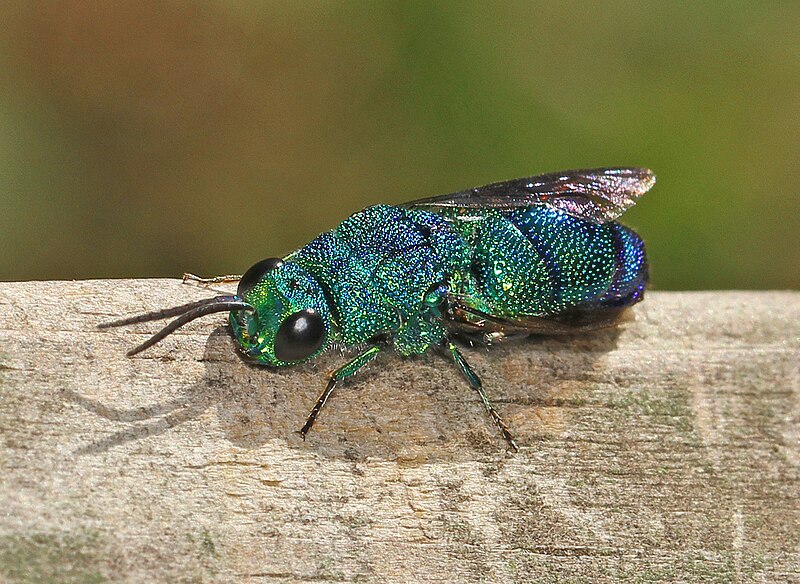
- Physical description: No larger than a housefly, but out of all the types of wasps, this one is one of the flashiest, with an iridescent blue-green body.
- Region: Found worldwide.
- Habitat and nests: The cuckoo wasp will place its egg in an unfinished and unattended nest of another wasp or bee. According to BayNature.org, They are most active in dry, open areas between May and August, with adults foraging on flower nectar as they search for solitary wasps and bees to parasitize.
- Behavior: This wasp gets its name from its similarities to the Cuckoo bird, which lays its eggs in the nests of other birds. Cuckoo wasps will curl up their body if they feel threatened, and are most often seen foraging on flowers.
Guinea Paper Wasps

- Physical description: Up to one inch in length with slender and narrow-waisted bodies. Wings are brown/black and bodies have yellow and brown-orange stripes.
- Region: Found in the southern United States and northern Mexico, but has also been observed in Missouri, Maryland, and New Jersey.
- Habitat and nests: This paper wasp constructs its nest from wood fibers to create a paper-like hexagonal structure. These nests are orientated downward and are held up by one filament. Satellite nests are also common for this wasp.
- Behavior: Similar to honey bees, this paper wasp species has three castes: workers, queens, and males. Queens lay all of the eggs in this colony. The Guinea Paper Wasp will only sting if it feels threatened.
Great Black Wasp
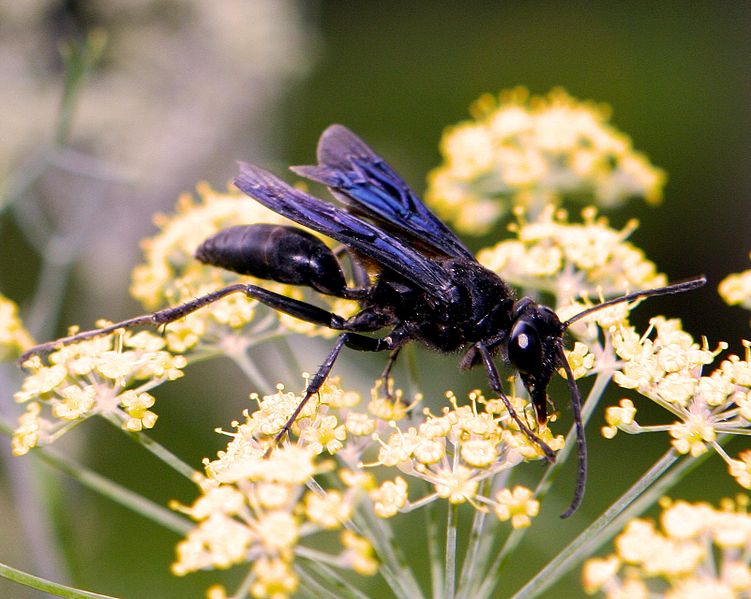
- Physical description: Black in color with no other stripes or markings. Large head and eyes, with a thin, threaded waist.
- Region: Found across North America.
- Habitat and nests: This is known as a digger wasp, meaning it creates its nest underground by digging holes. This is a solitary wasp that does not live with a colony.
- Behavior: Great black wasps will lay their eggs on other insects by stinging them three times to paralyze the prey. Females are the only ones that will sting, but it is very rare to encounter or be stung by one.
Horntail Wasp
- Physical description: Up to 1 ½ inches long and are identified by their thick waist. Colored blue, black, or reddish brown and have red, ivory, or yellow markings.
- Region: Found in Europe and North America.
- Habitat and nests: Also known as wood wasps, horntail wasps are wood-boring insects that live in newly dead or dying trees. Horntail wasps wil only attack trees and it is unlikely for them to cause structural damage to homes.
- Behavior: Horntail wasps are generally non-aggressive and according to InsectIdentification.org, they have two stingers – one of which is used to “by the female to directly inject eggs into tree trunks and other durable wood where they are less likely to be found.”
Mammoth Wasp
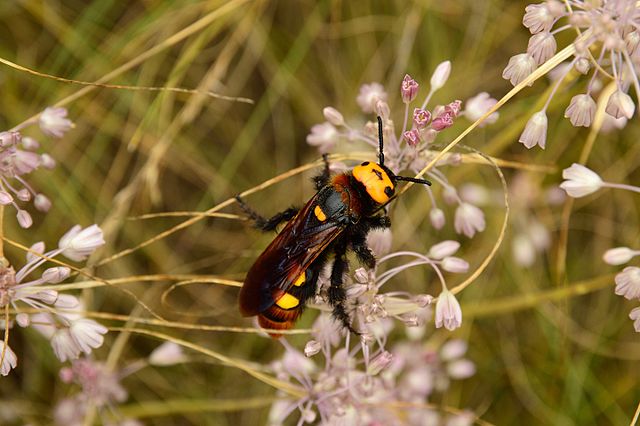
- Physical description: A large wasp that can grow up to 1.75 inches long. Females have a yellow face and short antennae, and males have a black face and longer antennae. This is the largest wasp in Europe.
- Region: Found in Mediterranean regions of Europe.
- Habitat and nests: Female mammoth wasps can be found around decaying wood and tree stumps.
- Behavior: This solitary wasp preys on beetles and after paralyzing it with its sting, it will lay an egg on the outer layer of the insect’s skin. Although their size is intimidating, they are not a threat to humans.
Wasp Prevention and Removal
According to Noah Wilson-Rich, Co-Founder of The Best Bees Company, “prevention” and “removal” should not be our first thought when it comes to wasps.
“I will always say if people see wasps, hornets, and yellow jackets in their environment, that’s actually a really good sign. That means you have a healthy habitat, and it’s what we call bio indicators of ecosystem health.”
Wilson-Rich urges people to reconsider the prevention of wasps because they play an integral role in our ecosystem. Not only are they helping nutrients cycle throughout, but through their predatory role, they eat problem bugs like grubs on the tomatoes in gardens. Above all, if you see a wasp nest that is not interfering with your life or home, it’s highly recommended that you leave the nest be. Typically, these nests will not survive the winter or rainy season, so nature will clear out the nest on its own when it is time.
Preventative measures are certainly better than pesticide-filed ones, but the best approach is to open our minds into not even just accepting the presence of wasps, but also thinking more about what we can do to promote these species.
Our CEO Noah Wilson-Rich’s Favorite Types of Wasp
“I know the most about paper wasps. There are some invasive species here from Europe, but they’re in all parts of the world. They are identifiable by their back legs that hang down when they fly and are a model study system for social evolution.”
How Noah Would Describe Wasps in Three Words
“Beneficial, knowledgeable, and awe-inspiring.”
FAQs
Q: Are hornets a type of wasp?
A: All hornets are a type of wasp, but not all wasps are hornets.
Q: How many types of wasps are there?
A: There are more than 30,000 identified species of wasps worldwide, and each vary in color, size, habitat, and nesting behavior.
Q: Do wasps bite or sting?
A: While it is dependent on the species, most wasps do have stingers and can sting more than once (but will only do so if they feel threatened. Wasps do have mandibles that allow them to chew wood fibers to create nests and to attack their prey.


